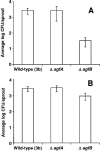Salmonella enterica virulence genes are required for bacterial attachment to plant tissue
- PMID: 16204476
- PMCID: PMC1265987
- DOI: 10.1128/AEM.71.10.5685-5691.2005
Salmonella enterica virulence genes are required for bacterial attachment to plant tissue
Abstract
Numerous Salmonella enterica food-borne illness outbreaks have been associated with contaminated vegetables, in particular sprouted seeds, and the incidence of reported contamination has steadily risen. In order to understand the physiology of S. enterica serovar Newport on plants, a screen was developed to identify transposon mutants that were defective in attachment to alfalfa sprouts. Twenty independent mutants from a pool of 6,000 were selected for reduced adherence to alfalfa sprouts. Sixty-five percentage of these mutants had insertions in uncharacterized genes. Among the characterized genes were strains with insertions in the intergenic region between agfB, the surface-exposed aggregative fimbria (curli) nucleator, and agfD, a transcriptional regulator of the LuxR superfamily, and rpoS, the stationary-phase sigma factor. Both AgfD and RpoS have been reported to regulate curli and cellulose production and RpoS regulates other adhesins such as pili. The intergenic and rpoS mutants were reduced in initial attachment to alfalfa sprouts by 1 log unit compared to the wild type. Mutations of agfA, curli subunit, and agfB in S. enterica serovar Enteritidis differentially affected attachment to plant tissue. The agfA mutation was not reduced in ability to attach to or colonize alfalfa sprouts, whereas the agfB mutation was reduced. Thus, agfB alone can play a role in attachment of S. enterica to plant tissue. These results reveal that S. enterica genes important for virulence in animal systems are also required for colonization of plants, a secondary host that can serve as a vector of S. enterica from animal to animal.
Figures



References
-
- Albertson, N. H., S. Stretton, S. Pongpattanakitshote, J. Ostling, K. C. Marshall, A. E. Goodman, and S. Kjelleberg. 1996. Construction and use of a new vector/transposon, pLBT::mini-Tn10:lac:kan, to identify environmentally responsive genes in a marine bacterium. FEMS Microbiol. Lett. 140:287-294. - PubMed
-
- Andersson, R. A., V. Koiv, C. Norman-Setterblad, and M. Pirhonen. 1999. Role of RpoS in virulence and stress tolerance of the plant pathogen Erwinia carotovora subsp. carotovora. Microbiology 145:3547-3556. - PubMed
-
- Ausmees, N., H. Jonsson, S. Hoglund, H. Ljunggren, and M. Lindberg. 1999. Structural and putative regulatory genes involved in cellulose synthesis in Rhizobium leguminosarum bv. trifolii. Microbiology 145:1253-1262. - PubMed
Publication types
MeSH terms
Substances
LinkOut - more resources
Full Text Sources

